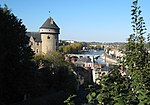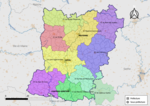Laval ([la.val] ) is a town in western France, about 300 km (190 mi) west-southwest of Paris, and the capital of the Mayenne department.
Its inhabitants are called Lavallois. The commune of Laval proper, without the metropolitan area, is the 7th most populous in the Pays de la Loire region and the 132nd in France.A part of the traditional province of Maine before the French Revolution, which now split between two departments, Mayenne and Sarthe, Laval also lies on the threshold of Brittany and is not far from Normandy and Anjou. It was thus an important stronghold in northwestern France during the Middle Ages. Laval became a city during the 11th century, and was the cradle of the House of Laval, one of the most powerful families in Maine and Brittany. The counts of Laval developed a textile industry around 1300 and made Laval a significant centre for the French Renaissance a century later. The linen industry remained the principal activity in Laval until the 20th century, when milk processing became more profitable.
Laval developed around a promontory, on which the castle was built, and along the river Mayenne. The Laval metropolitan area is a small economic centre in western France, particularly active in the industrial sector, dairy production, electronics and chemicals. Laval is economically oriented towards Rennes, the administrative capital of the region of Brittany, and located only 80 kilometres (50 miles) west of Laval.
Laval proper covers 34.2 square kilometres (13.2 sq mi) and has a population of 49,573 inhabitants, while c. 144,000 live in its metropolitan area (1,435 square kilometres (554 sq mi)). The Laval Agglomération intercommunality is made up of 34 communes covering 686 square kilometres (265 sq mi) with 113,000 inhabitants.Laval is notably the birthplace of Henri Rousseau, a major Naïve painter, and the town has a museum dedicated to him and other Naïve artists. Laval also enjoys a significant architectural heritage, with its castle, portions of city walls, medieval houses, old bridges and churches.







